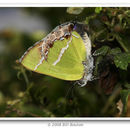fi
nimet breadcrumb-navigoinnissa


Chlorostrymon simaethis, the silver-banded hairstreak, is a North and South American butterfly in the family Lycaenidae.[2][3] It is also known as St. Christopher's hairstreak and the Key lime hairstreak.[4]
The upperside of the wings is dark, iridescent purple in males. Females are grayish brown, sometimes having iridescent purple on the basal area of the wings.[4] The underside of the wings is bright, lime green in both sexes. Both wings have a bright silvery-white postmedian band. The silver band on the hindwing juts out towards the margin and turns back in, forming a V shape. Beyond this band, there is a dark brownish-red patch with a variable amount of silvery-white frosting. The frosting extends across the entire edge of the hindwing. The hindwings have one pair of tails.[2][4] The wingspan ranges from 2.2 to 3.2 cm.[5]
The amethyst hairstreak (Chlorostrymon maesites) is the only similar species in the silver-banded hairstreak's range.
The amethyst hairstreak is smaller. The upperside of the male is dark, vivid, purplish blue. The upperside of the female is bright blue with dark forewing apexes. The underside of the forewing lacks the silver band. The hindwing has a silver band but it does not stretch across the entire wing. The hindwings have two pairs of tails.[4]
Another related butterfly species to Chlorostrymon simaethis found in North America is Callophrys xami, which is commonly referred to as the xami hairstreak or green hairstreak. Aesthetically, C. simaethis differs significantly from C. xami in regards to the postmedian white line running across the butterfly wings as the silver-banded species has a much broader silver-white postmedian line on the underside of the hindwing.[6]
The silver-banded hairstreak is found in habitats such as subtropical woodlands, deserts, and hammock edges. It is found in these habitats only if its host plants are nearby.[4][7]
The silver-banded hairstreak is seen from May to December in southern Florida and from June to December in southern Texas.[7] It is seen from March to June and again from October to mid-November in southern Arizona.[8] It will occasionally stray to southern California in October.
These butterflies are usually a very pretty light green with a white streak along the top of the wing. Some say this butterfly is a blue to a light brown. [7]
The female lays her eggs singly on the young fruits of the host plant. The eggs are shiny green. The caterpillar lives inside the seed pod of the host plant and feeds on the unripe seeds. The caterpillar is yellowish green to a brownish color.[7] It has dark, wavy dorsal and subdorsal lines.[9] There is a dark greenish middorsal stripe edged on each side with red ovals. The head is tan. The caterpillar will turn red just before pupating.[7] The chrysalis is tan to grayish brown with a gray middorsal stripe. It is covered in black and brown spots. It is attached to a surface by a silk pad and girdle.[7] The silver-banded hairstreak has two or three broods per year.[2]
Host plants of the silver-banded hairstreak:[7]
Chlorostrymon simaethis, the silver-banded hairstreak, is a North and South American butterfly in the family Lycaenidae. It is also known as St. Christopher's hairstreak and the Key lime hairstreak.
La Thécla verte ou Thécla de la liane persil (Chlorostrymon simaethis) est une espèce de lépidoptères (papillons) de la famille des Lycaenidae, sous-famille des Theclinae et du genre Chlorostrymon.
Chlorostrymon simaethis a été décrit par Drury en 1773, sous le nom initial de Papilio simaethis.
Synonymes : Chlorostrymon chileana Johnson, 1989; Mitoura simaethis, Dyar, 1903; Tmolus simaethis, Kaye, 1914; Chalybs simaethis, Kaye, 1921; Thecla simaethis, Kirby, 1871; Strymon simaethis, Barnes & McDunnough, 1917[1].
La Thécla de la liane persil ou Thécla verte se nomme Silver-banded Hairstreak en anglais[1],[2].
Chlorostrymon simaethis est un petit papillon d'une envergure de 22 mm à 32 mm qui possède à chaque aile postérieure une queue fine et longue[3].
Le dessus du mâle est marron avec une discrète suffusion bleu violet, celui de la femelle est gris.
Le revers est vert avec une bande postmédiane blanc argenté.
Chlorostrymon simaethis vole en deux générations entre aout et décembre[3].
Les plantes hôtes de sa chenille sont Cardiospermum corindum et Cardiospermum halicacabum[1].
Chlorostrymon simaethis est présent dans le sud de l'Arizona, de la Californie et du Texas, aux Antilles et dans toute l'Amérique du Sud, dont en Guyane[1],[4].
La Thécla de la liane persil réside principalement en zone sèche où se trouve la plante hôte de sa chenille Cardiospermum halicacabum[2].
Pas de statut de protection particulier.
La Thécla verte ou Thécla de la liane persil (Chlorostrymon simaethis) est une espèce de lépidoptères (papillons) de la famille des Lycaenidae, sous-famille des Theclinae et du genre Chlorostrymon.
Chlorostrymon simaethis is een vlinder uit de familie van de Lycaenidae.[1] De wetenschappelijke naam van de soort werd als Papilio simaethis in 1773 gepubliceerd door Drury.
Chlorostrymon simaethis is een vlinder uit de familie van de Lycaenidae. De wetenschappelijke naam van de soort werd als Papilio simaethis in 1773 gepubliceerd door Drury.